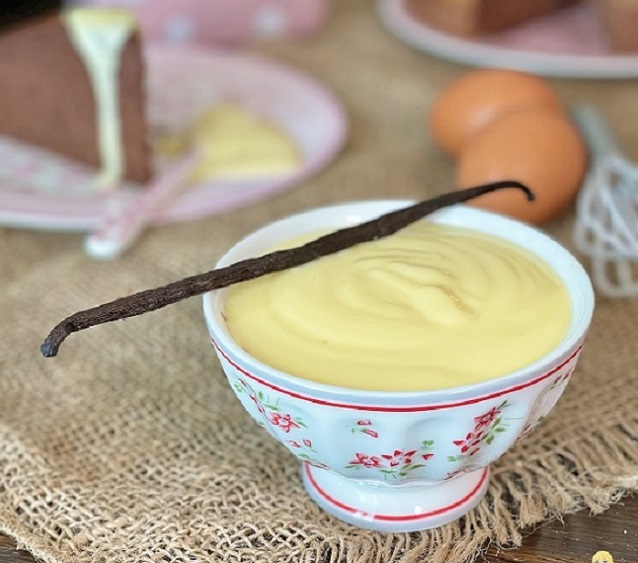
VANILLA CUSTARD Crème Anglaise
Before I started cooking regularly I always thought it was difficult to make custard. That if I tried I would burn everything and end up with something lumpy with slimy skin on it.
Actually, like pretty much everything I thought was hard to make, it’s really easy. There is only one simple rule to follow: you must give it all your attention, you must not take care of other things at the same time.
Custard is a generic term refers to a range of desserts and sauces made using milk or cream, eggs and a thickener. You can get firm piping custard (Creme Patissiere) like what you get in pies and cakes, that are firm enough to hold its shape, or a custard that’s used to pour over things (also known as Creme Anglaise).
Today we will prepare the Creme Anglaise together which I love because it is the ideal accompanying sauce for any dessert and takes it to the highest level.
It is a cream based on milk, sugar and eggs not to be confused with the classic custard which differs in the presence of flour or other thickener.
This difference in the ingredients also determines a substantial difference in the consistency: custard is dense and can be used as a filling cream, crème anglaise is more fluid and is chosen as an accompanying sauce.
What to use custard for? The list is very long. The most traditional way to use custard is with Christmas pudding but for me, though, I use it to doll up many desserts.
Custard is perfect for pouring over Apple Cake, or pour it over pancakes, with banana bread or bread and butter pudding, crumbles, waffles, scones, or just pour it over a bowl of fruit.
Creme Anglaise will give an extra edge to all your preparations, even the less tasty ones with a more neutral flavour.
Don’t you want to try it? Let’s see how it is prepared now.
Related recipes

Video recipe of the day
- DifficultyVery easy
- CostVery cheap
- Cooking methodOther
- CuisineFrench
Ingredients
- Power 139,07 (Kcal)
- Carbohydrates 14,99 (g) of which sugars 14,96 (g)
- Proteins 4,50 (g)
- Fat 7,04 (g) of which saturated 3,40 (g)of which unsaturated 3,64 (g)
- Fibers 0,02 (g)
- Sodium 7,87 (mg)
Indicative values for a portion of 60 g processed in an automated way starting from the nutritional information available on the CREA* and FoodData Central** databases. It is not food and / or nutritional advice.
* CREATES Food and Nutrition Research Center: https://www.crea.gov.it/alimenti-e-nutrizione https://www.alimentinutrizione.it ** U.S. Department of Agriculture, Agricultural Research Service. FoodData Central, 2019. https://fdc.nal.usda.gov
Tools
WHY PREPARE VANILLA CUSTARD AT HOME
My recipe uses only ingredients that I always have at home, so I can suddenly decide I need a bowl of warming bananas and custard and as if by magic it’s there.
Knowing that I’ve made something that I’d always thought was difficult (even if it actually isn’t) makes me feel clever, and I like feeling clever.
STEP 1
Separate egg whites from yolks, put yolks in a bowl, add sugar and vanilla pod seeds. Beat with an electric whisk until the mixture is light and fluffy. Add milk at room temperature, little at a time, and continue mixing with a hand whisk.
Transfer mixture into a saucepan and cook over a low heat on the stove, stirring constantly. The temperature of the cream must not exceed 185 F (85 C) . Use kitchen thermometer. The cream cooks for a maximum 5 minutes. When temperature reaches 185 F (85 C) remove pan from the heat and pour onto a plate to cool. Vanilla Custard is ready to use.

ADVICE
Vanilla bean will give this a truly fabulous vanilla flavour but you could use 1 tsp vanilla bean paste or extract instead. Vanilla essence is artificial so it won’t provide as nice a flavour. You can replace vanilla with lemon zest for a more aromatic cream.
Leftover egg whites: puoi preparare delle deliziose meringhe, here’s my recipe.
Serve with desserts, over fruit, pancakes, waffles, bread & butter pudding.
Vanilla Custard can also be made with the addition of double cream for a creamier consistency and a more enveloping flavour. You will need: 500 ml of double cream, 8 egg yolks, 160 g of sugar, 1 pinch of salt, 1 vanilla pod.
Kitchen thermometer. If you don’t have a kitchen thermometer, you can tell if the cream is ready by dipping a spoon into it: if it comes out cloudy, the custard is ready.
The cream must not be too thick and cooks for a maximum of 5 minutes.
If the cream exceeds a temperature of 185 F (85 C) it forms lumps. If this happens to you, don’t worry, you can try adding a spoonful of cold water and filter through a fine mesh strainer. Put it back in a pan and let it thicken slightly over a very low heat.
STORAGE
The custard can be stored in the refrigerator covered with cling film for a maximum of 2 days. It is not suitable for freezing.
Frequently Asked Questions (FAQ)
What are the types of custard?
There are 2 types of custard: baked and stirred.
Baked custards include bread pudding, flan, and cheesecake, and are prepared by baking in an oven or water bath.
Puddings, creme anglaise , and pastry cream are some examples of stirred custards.
What is the difference between Creme Anglaise and Custard?
The difference between the two lies in the thickness and ingredients. Custard is thicker than custard and uses flour or another thickener. It is usually used to fill cakes.
On the contrary Creme Anglaise is more liquid and prepared only with egg yolks, milk or cream, sugar and vanilla. Creme Inglese is used to accompany desserts or biscuits.
Varied doses for servings
